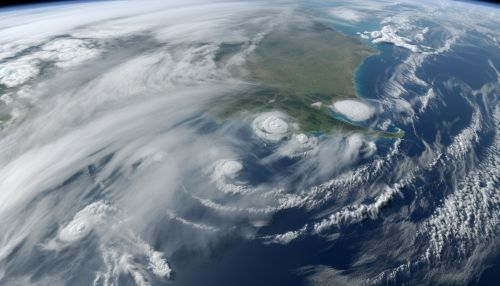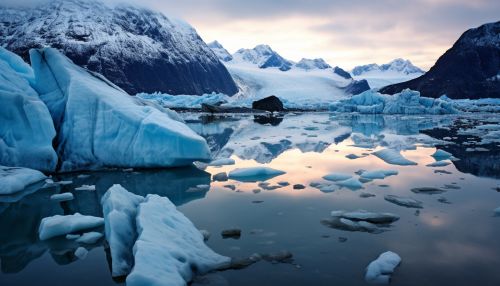Aleutian Low
Overview
The Aleutian Low is a semi-permanent, subpolar area of low pressure located in the Gulf of Alaska near the Aleutian Island chain. It is one of the main centers of action in the atmospheric circulation of the Northern Hemisphere, one of the key nodes in the planetary wave pattern, and a primary factor in the distribution of climatic zones and ecosystems on the North American continent.


Characteristics
The Aleutian Low is characterized by many attributes, including its location, intensity, and the climatic impacts it has on the surrounding regions. It is a large-scale atmospheric feature that covers a vast area and is most intense during the winter months. The low is not a single, continuous entity, but rather a region filled with a series of migrating low- and high-pressure systems that vary in intensity and duration.
Formation
The Aleutian Low forms as a result of the interaction between the cold air masses from the Arctic and the warm, moist air masses from the Pacific Ocean. This interaction leads to the development of a thermal gradient, which in turn leads to the formation of the Aleutian Low. The low is further influenced by the Earth's rotation and the Coriolis effect, which causes the air to rotate counterclockwise around the low in the Northern Hemisphere.


Climatic Impacts
The Aleutian Low plays a significant role in the climate of the North Pacific and North America. It influences the path and intensity of cyclones, contributes to the distribution of sea surface temperatures and salinity, and affects the marine and terrestrial ecosystems. The low is also associated with the Pacific Decadal Oscillation (PDO), a long-term ocean fluctuation of the Pacific Ocean that has a significant impact on the climate.
Influence on Marine Ecosystems
The Aleutian Low has a profound impact on the marine ecosystems in the North Pacific. The low-pressure system influences the distribution of nutrients in the ocean, which in turn affects the productivity of marine ecosystems. The Aleutian Low is also associated with the upwelling of nutrient-rich waters, which supports a high level of primary productivity and sustains a diverse and abundant marine life.


Influence on Terrestrial Ecosystems
The Aleutian Low also impacts the terrestrial ecosystems of the North Pacific and North America. The low-pressure system influences the regional climate, which in turn affects the distribution and productivity of terrestrial ecosystems. The Aleutian Low is associated with the distribution of precipitation, which influences the growth and distribution of vegetation and wildlife.


Future Changes and Impacts
Climate change is expected to influence the characteristics and impacts of the Aleutian Low. Models suggest that the Aleutian Low may become more intense and shift its position in response to global warming. These changes could have significant implications for the climate and ecosystems of the North Pacific and North America.


